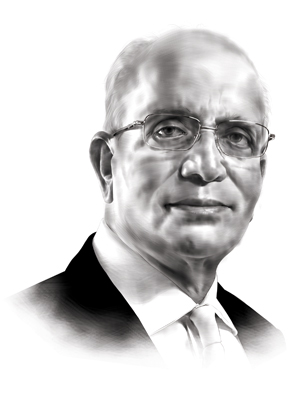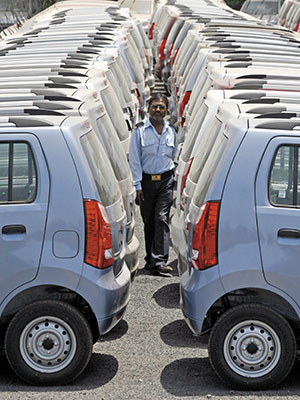
The car industry is poised to accelerate: RC Bhargava
Transparency, reforms like GST, interest rate cuts and overall economic growth can rev up the car industry's prospects in the new year
The passenger car industry has been struggling ever since 2011-12. Since then, car manufacturers have hoped that the next year would see the industry getting back to the average of about 15 percent growth rates witnessed in the decade before 2011-12, but that has not happened. Car sales in 2014-15 were 1 percent lower than in 2011-12, though this year the sales figure should be 5 percent or so higher than 2011-12, representing a 6 percent growth. What should we expect in 2016-17?
The long-term rate of growth of car sales in any developing country is largely determined by the pace of economic growth and the extent to which the growth is inclusive. The wider the benefits of economic growth, the larger will be the number of people who will be able to afford a car. In India, the rate of economic growth had started to slow after the global events of 2008. Various events, largely national, had subsequently resulted in creating a climate of despondency in the country and economic growth, as well as manufacturing activities, fell to low levels.
The political changes after 2014, and the sudden surge of optimism among the people, certainly helped turn around sentiment. This has reflected in car sales once again getting back to a growth trajectory, even though double-digit growth is yet to be achieved. However, the expectations of growth and job creation reaching high levels in a short period of time have now given way to a more realistic appreciation of the tasks ahead. People are slowly realising that ‘good days’ will take time in coming.
There is little doubt that reforms are required in most sectors of the economy and, in many cases, incremental reforms will not be adequate. Disruptive changes in systems and thinking are required. The problem is that in a democracy like ours, reforms can happen only through consensus, and that will almost inevitably mean gradual and incremental changes. Thus, raising our capability to become globally competitive in manufacturing, increasing the share of manufacturing in GDP to at least 25 percent and making growth more inclusive will be a much slower process than what people expected after Narendra Modi became the prime minister.
The government has been making reforms and has taken steps to accelerate economic growth. Thus infrastructure construction has been given priority and doing business has become somewhat easier. There is greater transparency in the way the government works. The results were seen in the second quarter GDP data of this fiscal, growth having risen to 7.4 percent. More significantly, manufacturing sector growth has increased to 9.3 percent. Hopefully, this trend of the manufacturing sector growing will continue, with a positive impact on car sales.
Growth rates in 2015-16 would have been higher if the monsoons in 2014 and 2015 had not been well below normal. That has resulted in depressing the rate of growth of the agricultural sector to around 2 percent and car sales in rural areas grew at less than half of the earlier rate. Rural car sales growth in the last few years has been a major factor in Maruti not showing a decline in sales numbers. Hopefully, 2016 will see a better monsoon and a revival in rural sales growth to about 20 percent.
Another area where the government’s efforts have yielded results is interest rates. Both the industry and the government have been emphasising the need for interest rates to be reduced to promote investments and growth. The central bank has responded positively and cut repo rates by 1.25 percentage points this year. This decision became possible because of the negative inflation rates. The banks have not yet passed on the full extent of the cuts to the borrowers, but it is likely that this may happen in the next few months. Since over 70 percent of car sales are financed, there is no doubt that interest rates do influence the decision to buy cars. The continued negative wholesale price inflation may lead to further interest rate cuts in 2016. If that happens, and banks lower interest rates, sales of cars will benefit.
In fact, low inflation would also help car sales as the disposable incomes of prospective buyers would increase. Since higher car sales are related to disposable incomes, this will be another positive factor going forward.
In the last year, many other events have taken place that are favourable for the growth of the car industry. The absence of a policy regarding pricing of petrol and diesel had, in the past, created uncertainty among manufacturers and led to manufacturing capacity mismatches with demand. The present government has corrected this situation. There is now clarity and objectivity about the method of pricing of petrol and diesel. That is certainly favourable for better planning of investments and production.
Going forward, the recent valid concerns about the environment may once again impact the sale of diesel cars, as the implementation of Bharat Stage V emission standards for such cars is still some years away, thanks to the inability of the refineries to produce appropriate fuel. It is possible that 2016-17 may see some adverse impact on sales as a result.
Since last year, global crude prices have been falling and have resulted in a reduction of fuel prices. The expectation is that the price of crude may fall even further. In any case, we should see reasonably stable prices of petrol and diesel. This will be a favourable factor for the growth of car sales, as it increases the ability of marginal customers to afford a car.
Commodity prices of steel, aluminium, copper and precious metals have been falling for some time and this trend is expected to continue. The cost of production of components and cars has come down as a result. This should reduce the possibility of car companies increasing the price of cars. However, the rupee has been weakening against the US dollar and since the import of components is often linked to the dollar rate, there would be an increase of costs of production as a result. Overall, lower commodity prices would favour growth of car sales.
Shortage of coal supplies and the high cost of imported coal were impediments to economic growth in past years. The present government could resolve the domestic issues relating to coal block allocations. The newly auctioned coal mines should start to work in the next financial year and that will lead to higher economic growth. Both power generation as well as the production of commodities like cement will benefit from this. Road building activities have already accelerated and will result in not only creating jobs but also help economic growth.
A very important reform under process is the introduction of the Goods and Services Tax (GST). It will not only simplify the taxation structure, but also result in turning India into a single market. The industry is hoping that political parties will resolve their differences and get this reform implemented by April 2016. National interest demands that such a major tax reform should not be delayed any further. As far as the automobile sector is concerned, GST will substantially improve the logistics of selling cars and spare parts, making their movement unhampered by tax considerations. The transportation of cars by road should also become cheaper and faster as trucks would not need to stop at various barriers along the way.
We have seen over many decades that cost and time overruns in projects are the rule rather than the exception. Policies are inadequately implemented and laws are not enforced. High rates of economic growth, and the ability to be globally competitive, requires us to fully implement our plans and policies. Civil servants must be made accountable for results, as well as incentivised to perform. Legal and other obstacles need to be removed.
Perhaps the biggest challenge is to change the distrust that exists among politicians, bureaucrats and industrialists. The root cause of the failures on the execution front usually stems from this distrust and the laws, regulations and systems that have developed as a consequence. Manufacturing has lagged behind in India partly because of the primacy given to the public sector, but more importantly due to the belief that private industrialists are rich people and hence industry can afford to subsidise other segments of society. There is no political will to remove the impediments that add to manufacturing costs.
In conclusion, and after considering the pressure of the people for jobs and growth, I would hazard to forecast that the car industry would grow 7-8 percent in 2016-17.
(This story appears in the 22 January, 2016 issue of Forbes India. To visit our Archives, click here.)
















